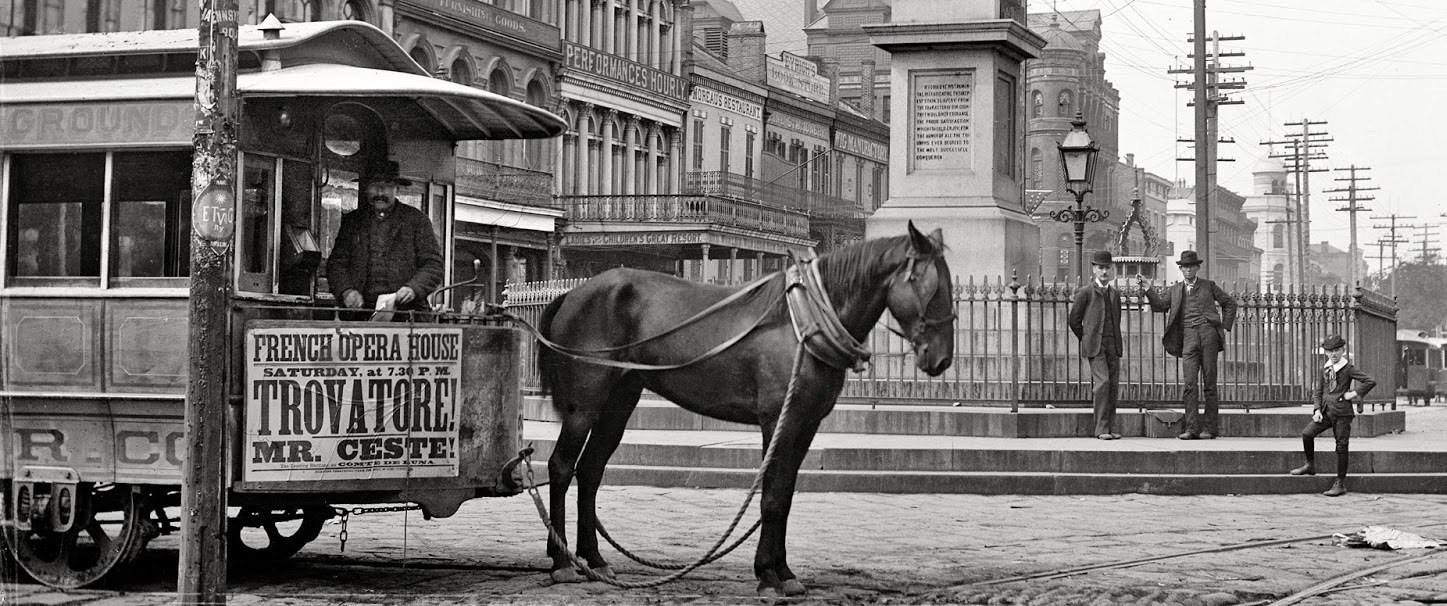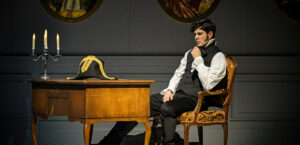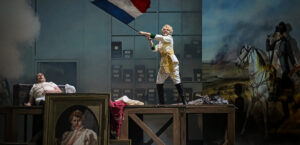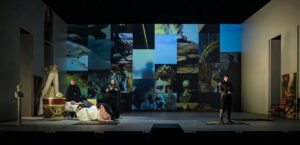The only play by Edmond Rostand still put on by Polish theatre companies is Cyrano de Bergerac. Occasionally Les Romanesques will stray onto one of the provincial stages. Few people remember his L’Aiglon (Eaglet), not performed in Poland for more than ninety years, although this powerful six-act historical fresco, written especially for Sarah Bernhardt, who played the eponymous character of Napoleon’s hapless son at the Paris premiere in 1900, arrived in Warsaw before the Great War and was enthusiastically received. The staggering career of the play, which Cornelia Otis Skinner compared in her biography of Bernhardt to a new victory at Wagram, was one of the greatest cultural phenomena in the theatrical life of the first half of the twentieth century. It earned Rostand a place in the Académie française when he was just thirty-three. In its first season in Paris L’Aiglon ran for at least 230 performances. Immediately translated into other languages, the play was all the rage around the world, from New York to Sofia. In 1924 audiences at Bydgoszcz’s Municipal Theatre forced the company to present additional performances – the poster proclaimed on 15 July that L’Aiglon would be presented “definitely for the last time, by general request”.
Rostand quite seriously considered the possibility of transferring his dramatic works onto the operatic stage. When he died prematurely in 1918, during the Spanish flu epidemic, the idea was picked up by his heirs. Apparently, of all Rostand’s theatrical legacy, only Chantecler was not turned into a musical work. The best librettos based on his plays came from the pen of Henri Cain, co-author of the successes of most of Parisian belle époque composers, including Massenet. Cain also adapted L’Aiglon. However, it took an opera to his libretto a long time to hatch – the proposal to write it was rejected at first by both Jacques Ibert and Arthur Honegger, who had been friends since their time at the Paris Conservatoire. It was not until 1936 that they changed their minds, when they were both approached by Raoul Gunsbourg, director of the Monte Carlo Opera. They saw in L’Aiglon the potential to be a work for new, difficult times. They decided to join forces and create an opera for the masses, a musical manifesto of opposition to the brownshirting of Europe, in line with the cultural policy of the newly formed Popular Front.
Gabriel Rollinson (Fürst von Metternich). Photo: Andreas Etter
Work on the piece lasted from mid-1936 to January the following year. The two composers decided to divide the responsibilities and efficiently implemented their concept, without paying much attention to either the librettist or the theatre’s director. Drawing on the tradition of the French grand opéra, they used a five-act structure, combining the material from the first two parts of Rostand’s play in the first act of the opera. They also reduced the number of characters – by about half, which still means that there are twenty more or less elaborate solo parts in the opera. Yet the work is relatively short, lasting just under two hours, and thanks to its skilful combination of the conventions of opera and operetta, historical fresco and dance divertissements, it does not drag on even for less sophisticated listeners, especially given that the score contains echoes of popular songs and marches, Viennese waltzes, dark sarabandes as well as clever references to the legacy of composers of past eras, including Haydn, Meyerbeer and Verdi. The lyrical framework of the whole – the outer acts – was written by Ibert, the middle acts, carrying a greater dramatic load, are the work of Honegger. Nevertheless, Act Three features a ballet composed by Ibert and the dense orchestration of some passages in Act One betrays the hand of his colleague. This only testifies to excellent collaboration between the two on this hybrid piece, which at times irresistibly brings to mind associations with film music – which is not surprising, given that both Ibert and Honegger had considerable experience in the field (the latter even “Napoleonic” experience, as the composer of the soundtrack to the silent film masterpiece directed by Abel Gance).
The friends showed infallible intuition: the premiere on 11 March 1937 – featuring Fanny Heldy as the Eaglet, Vanni Marcoux as the old soldier Flambeau and the American baritone Arthur Endrèze, highly regarded in France, as the demonic Chancellor Metternich – was a staggering success. A year later L’Aiglon triumphed at Brussels’ La Monnaie. After the war the opera returned to the stages of several French theatres; the 1952 staging at the Paris Opera, conducted by Cluytens, became legendary thanks to the soprano Géori Boué’s phenomenal interpretation of the eponymous character. The twilight did not come until the 1960s, with a general crisis in the popularity of the French repertoire. The revival of L’Aiglon began towards the end of last century – with moderate success. Had it not been for the award-winning live recording from La Maison Symphonique de Montréal conducted by Kent Nagano and published by Decca in 2016, the fruit of Ibert and Honegger’s collaboration might have remained forever in the archives, of no interest to anyone except opera historians.
Alexandra Samoulidou (L’Aiglon). Photo: Andreas Etter
This season L’Aiglon came to the Staatstheater Mainz, which stands on a square built on Bonaparte’s orders at a time when Mainz was the capital of the French department of Mont-Tonnerre. After an excellent experience with the local production of Idomeneo, I returned to the city on the Rhine, motivated more by curiosity than belief in the value of the forgotten adaptation of Rostand. I was very pleasantly surprised – even if L’Aiglon is not a masterpiece, it is definitely nicer to see a wise and thoughtful staging of an opera that is excellently cast, expertly conducted and performed with genuine engagement, than with yet another striking directorial vision of a work from the standard international repertoire, which in Poland rarely goes hand in hand with adequate preparation of the artists involved.
This time, too, the musical side of the production was in the hands of Hermann Bäumer, who will soon take over as artistic director of the State Opera in Prague. Luisa Kautz, born in 1987, a graduate of the Hochschule für Musik und Theater Hamburg, directed the staging, preparing it in collaboration with the set designer Valentin Mattka, the costume designer Tanja Liebermann, the projection designer Judith Selenko and the lighting director Frederik Wollk. In part of her concept Kautz consciously drew on the 1900 theatrical original: she had the Eaglet dressed in a snow-white uniform modelled on Jacques Doucet’s design for Sarah Bernhardt and the scene of his death resemble the finale of the famous Parisian production, in which Napoleon II was dying on a bed standing next to the elaborate cradle of the would-be successor to the French Emperor. This, however, was where the similarities ended. The Mainz production of L’Aiglon – the story of the Duke of Reichstadt, deprived of his father’s name, title and inheritance by the Holy Alliance, brought up at the Schönbrunn Castle as if in a golden cage, followed by the secret police of Metternich, who resolved to deny him accession to any throne in Europe at all costs – is a story of a gradual disintegration of the personality of Bonaparte’s only legitimate offspring, of the anguish of a man-child who tries unsuccessfully to break free from the custody of the Austrian chancellor and then sinks into the abyss of a terminal illness.
The harbingers of his ghastly phantasmagorias appear already Act One, when a precisely drawn diagram of a battle emerges from beneath a kitschy painting of mountains and the spectres of Napoleon’s soldiers descend from the walls. The horror intensifies in Act Two, played out in the almost empty space of a chamber hung with portraits of ancestors. This is when Metternich – in a brilliant scene reminiscent of the confrontation between Baron Scarpia and Tosca – utterly humiliates the Eaglet, showing unabashed contempt for his father, and then reproaches him for his weakness and ascribes to him all the Habsburg vices inherited from his mother. The ballet from Act Three becomes a pretext for the young man’s grotesque journey into the depths of his lost childhood, played out on a tiny stage – visible perhaps only through the eyes of his imagination – to the rhythm of the courtiers’ prancing at a masked ball. In Act Four the Eaglet’s escape is intertwined with a frenzied vision of the Battle of Wagram, experienced again following the death of the faithful Flambeau – in a setting reminiscent of an abandoned warehouse of memorabilia from Bonaparte’s glory days. In the finale the battle cloak of black eagle feathers gives way to a white bedspread lined with chick down that covers the body of the dying prince. “Meine Geburt und mein Tod sind meine ganze Geschichte” – my whole story comes down to birth and death. Luisa Kautz closes the tale of Napoleon’s son with an expressive theatrical gesture, against a background of the Eaglet’s fragmented memories and deathbed delusions.
The fifth act, finale. Photo: Andreas Etter
The title role was convincingly played by the young Greek soprano Alexandra Samoulidou, whose voice is sensual, dark in tone, perhaps too “feminine” at times – but on the other hand consistent with the more than century-old tradition of interpreting Rostand’s protagonist, standing halfway between boyish naiveté and never-fulfilled masculinity. An outstanding portrayal of Flambeau came from the American bass-baritone Derrick Ballard, whose performance was in line with the nineteenth-century buffo caricato convention, usually associated with the roles of braggart soldiers, but in this particular case marked by a strong note of tragedy. Another singer who caught my attention among the huge cast of L’Aiglon was Gabriel Rollinson. His Metternich was all the more sinister, as he poured venom into the Eaglet’s ear in free-flowing, beautifully constructed phrases produced by a baritone voice with a heartbreakingly beautiful sound, so rare these days: melancholic, smoky, resembling the voice of a young Andrzej Hiolski. In fact, each of the soloists in this production deserved separate praise, as did the members of the company’s chorus and the instrumentalists of the local Philharmonischer Staatsorchester, playing vigilantly under Bäumer with a luscious sound and enthusiasm rarely encountered in Polish ensembles, but testifying clearly to the musicians’ excellent rapport with the conductor.
“Droves of people watched,” Zygmunt Krasiński wrote, remembering the Eaglet’s funeral. All that remains to be said is that nearly two hundred years after those events the audience followed the tragic fate of Napoleon II on the Mainz stage in just as large numbers, though perhaps more attentively. The staging of the rediscovered opera by Ibert and Honegger will be presented “definitely for the last time” on 25 May. It is worth going to Mainz to see it, as the world is again turning brown.
Translated by: Anna Kijak



